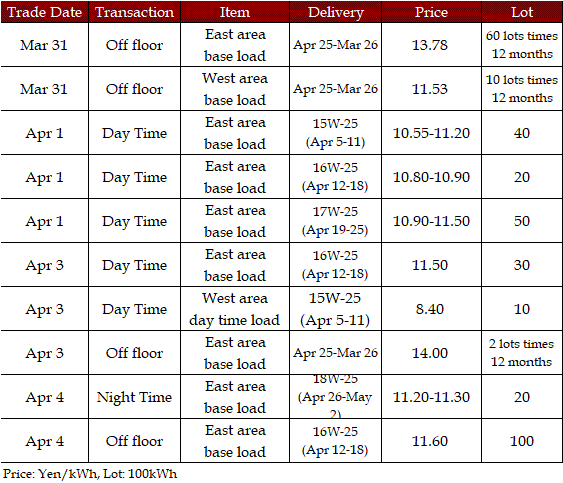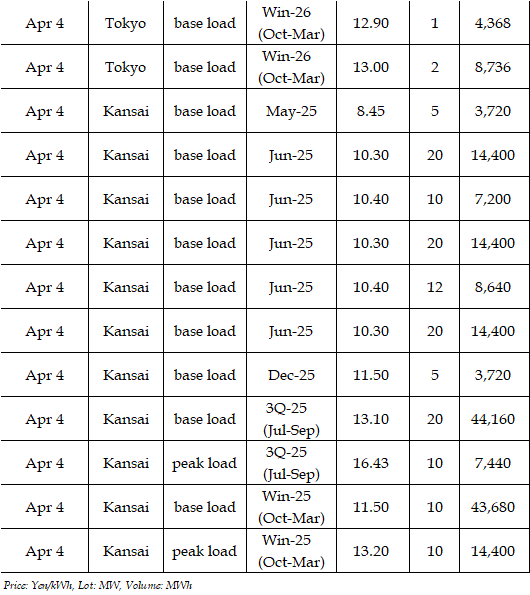|
In the day-ahead market on JEPX (Japan Electric Power Exchange), the 24-hour spot power prices on a weekly average basis for Mar 31-Apr 4 delivery rebounded steeply from the previous week in both East Japan (50Hz) and West Japan (60Hz). A fall in reserve rates bolstered spot prices with an increasing number of thermal units idled mainly for regular maintenance starting Apr 1. In addition, heating demand picked up in East Japan as the highest temperature in Kanto was capped around 10 degrees with a return of unseasonal chilly climate. Besides that, the weather was cloudy mostly during the week, leaving limited scope for photovoltaic generation. Thus, supply-demand fundamentals tightened up obviously, pushing up spot prices in East Japan more rapidly than those in West Japan.
In Shikoku, the Honshu-Shikoku Interconnection Line suspended operation since Mar 23 night in the aftermath of wildfires that occurred in Imabari city in Ehime prefecture and Okayama city. But the Interconnection Line returned to operation starting Apr 1, allowing an outflow of power supply from Shikoku to the mainland. This helped correct extreme lows in spot prices in Shikoku, sending back the market to a normal situation in Shikoku.
In Tokyo and Kansai, the key areas in East Japan and West Japan, the 24-hour average posted a difference in favor of the East by Yen 3.22 for Mar 31 delivery, Yen 3.60 for Apr 1 delivery, Yen 4.80 for Apr 2 delivery, Yen 5.75 for Apr 3 delivery and Yen 2.82 for Apr 4 delivery. The East-West gap widened remarkably from the previous week.
The fuel market trends in the first week of April were detailed as follows.
DES Northeast Asia spot LNG prices stood in the low $13 per mmBtu for prompt May 2025 arrival as of Apr 3, stable from the end of the previous week (Mar 28). The LNG market moved in line with natural gas prices in Europe. In addition, looming uncertainty over the Russia's situation left the LNG market directionless. In Northeast Asia, meanwhile, supply-demand fundamentals continued to loosen up amid an ongoing slump in buying interest combined with growing availability. The Ministry of Economy, Trade and Industry (METI) announced on Apr 2 that Japan's LNG inventories for power generation stood at 2.24 mil mt as of Mar 30, up 410,000mt from a week before. The figure was up both from 1.48 mil mt as of end-March last year and the average of past five years at 2.03 mil mt.
FOB Newcastle thermal coal prices in Australia stood in the mid $99 level per ton for April 2025 loading as of Apr 3. The level was down more than $4 from the end of the previous week, in reaction to a loss in gas and crude oil prices.
In the crude oil market, WTI crude for May 2025 in the mid $66 level per barrel as of Apr 4 morning while Brent crude for June 2025 was trading at slightly below $70. Both WTI and Brent were down around $3 from the end of the previous week. Crude futures found support from concerns over a squeeze in crude oil supply from Russia and Iran. On the other hand, the market was overshadowed by the outlook for output hikes by the Organization of the Petroleum Exporting Countries (OPEC) and non-OPEC producers, or OPEC plus. Especially, US President Donald Trump on Apr 2 Wednesday unveiled his plan to impose tariffs against all countries in the globe, raising concerns over the outlook of the global economy and prompting market players to sell off risk assets such as crude oil and equities.
The actual highest price during the week was at Yen 20.96 in Hokkaido for Apr 3 delivery. Meanwhile, the actual lowest price during the week was at Yen 0.01 in Shikoku and Kyushu for Mar 31 and Apr 2-4 delivery as well as six areas in West Japan for Apr 1 delivery.
By area, the weekly average of the 24-hour spot prices was at Yen 14.74 in Hokkaido, up Yen 4.74 from the previous week, Yen 15.12 in Tohoku, up Yen 5.57, Yen 15.66 in Tokyo, up Yen 5.90, Yen 11.79 in Chubu, up Yen 3.14, Yen 11.63 in Hokuriku and Kansai, up Yen 3.79, Yen 11.21 in Chugoku, up Yen 3.39, Yen 7.84 in Shikoku, up Yen 5.74, and Yen 10.01 in Kyushu, up Yen 2.55.
In the JEPX auction, volumes of offers were 1,051.60 mil kWh on a weekly average basis, down 25.2% from the previous week. Meanwhile, bids on a weekly average basis grew by 7.2% to 930.43 mil kWh. The weekly average of trade volumes waned by 5.1% to 724.67 mil kWh.
Power demand in nine areas of Japan during Mar 31-Apr 4 was a combined 11,938.35 mil kWh, up 13.5% from 10,519.36 mil kWh during Mar 24-28. The figure was up 10.1% from the corresponding period a year earlier. Demand during Apr 1-5, 2024 after day of week adjustment was 10,847.14 mil kWh.
Deals reported on TOCOM (Tokyo Commodity Exchange) during Mar 31-Apr 4 were as below.

Deals reported on EEX (European Energy Exchange) during Mar 31-Apr 4 were as below.





In the second week of April, spot prices are expected to come under pressure compared with the first week. In East Japan, the highest temperature is forecast to stay above 20 degrees in the second week in contrast to freezing climate in the first week, so that heating demand is likely to decrease massively. In West Japan as well, the temperatures are expected to rise above 20 degrees, a level that is too mild to use neither air-conditioning nor heaters. In addition, sunshine will be available except on Apr 11, and a glut in solar power supply is expected to loosen up supply-demand fundamentals. Citing the price outlook in the second week, a source at a power producer and supplier said, "In both East Japan and West Japan, the 24-hour average will fail to reach Yen 10, and the wide East-West price gap will also be corrected sharply." Weather conditions are expected to leave day time prices low and push up night time prices, so that spot prices are believed to post a "duck curve" pattern mostly during the week.
|
JEPX: System Price (Day Ahead 24 hours)
|
|
Weekday Price
|
31-Mar
|
1-Apr
|
2-Apr
|
3-Apr
|
4-Apr
|
|
24-Hour Ave
|
10.77
|
14.37
|
12.62
|
13.45
|
11.62
|
|
Volume (MWh)
|
778,084
|
696,542
|
692,507
|
720,719
|
735,519
|
|
(unit: yen per kWh) (date: delivery day)
|
|
|

|